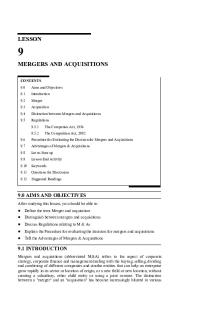mergers and acquisitions PDF

| Title | mergers and acquisitions |
|---|---|
| Course | Mergers & Acquisitions, Financial Distress & Restructuring |
| Institution | EDHEC Business School |
| Pages | 3 |
| File Size | 85.9 KB |
| File Type | |
| Total Downloads | 98 |
| Total Views | 139 |
Summary
Download mergers and acquisitions PDF
Description
M&A I-
working cap = (Inventories + Account receivables + Tax & social receivables) – (Account payables + Tax & social liabilities) Net debt = (Long term debt + bank debt ) – (Long term financial assets + Cash) Accounting view : Net operating assets = Equity + Net debt Financial view: Net operating assets value = Equity value + Net debt value Enterprise value= equity value + Net debt (Net debt value = Net debt) Enterprise value is the value of the operating assets of the company no matter how they get financed Equity value is the value of shares Book value is the balance sheet view of the equity
II-
-
Entreprise value to equity value
Valuation
Two approaches: o Direct approach = value direct the equity o Indirect approach = Value first the enterprise value Two family of methods: o Relative methods: Peer comparison, analogical method, Multiple method o Intrinsic methods: Valuing a company only based on its own information (DCF) a) Relative methods
- Equity value (=Direct approach)= Multiples on EBT, net income (P/E), Price to book influenced by financials - Enterprise value (= Indirect approach) = Ebitda and EBIT multiples - Method: o Build a sample of comparable companies: Activity type; Sectors; Profitability & Size; Geography o Select the relevant multiple: Turnover; EBITDA; PE … o Normalized these multiples: Accounting methods; Exceptional items; Tax distortion o Adjust multiples: Size discount; Shares liquidity; Control premium; Geographic and sector diversification - Two types of multiples: o Listed multiples o Transaction multiples b) Intrinsic value methods -
FCF= EBITDA – Theorical income tax on EBIT – CAPEX – WCC = EBIT – Theorical income tax on EBIT – CAPEX + D&A – ∆WCC Enterprise Value = Somme CF / WAC^n + Terminal value
-
-
Terminal value = CF last year / (WACC – g) Limitation / Going further: o This method tends to consider CF as the end of the year which means that for a company with relatively spread CF over the year it is not that precise. Another option is to discount CF each 6-months o Terminal value can also be computed by an exit multiple (EV/EBITDA or EV/Sales) or by assuming a progressive convergence of company’s ROCE (=Post tax EBIT/ Capital employed) to the WACC over a period called competitive advantage period Other valuation methods: o FCFE (value directly equity ) = Net income – CAPEX + D&A –∆WCC + ∆Net debt Discounted at cost of equity o DDM = Discounted the future dividend (Used in bank insurance valuation o Net asset value = Looking at the company own asset (Indication) o Sum of the parts = Sum a company Business units if highly diversified
III-
Net debt adjustments impacting valuation
-
We need a normative WCC value, if not we need to adjust the net debt
-
Consolidation impact: - >50% o Value the company including those items at 100% and then correct the Net debt (minority interest as a debt like item), or o Restate the consolidated accounts to cancel minority interest item in DCF - Investment in affiliate (...
Similar Free PDFs

mergers and acquisitions
- 3 Pages

Mergers and acquisitions
- 10 Pages

Mergers and Acquisitions notes
- 125 Pages

Mergers and Acquisitions Summary Notes
- 160 Pages

M&A Outline - Mergers & Acquisitions
- 46 Pages
Popular Institutions
- Tinajero National High School - Annex
- Politeknik Caltex Riau
- Yokohama City University
- SGT University
- University of Al-Qadisiyah
- Divine Word College of Vigan
- Techniek College Rotterdam
- Universidade de Santiago
- Universiti Teknologi MARA Cawangan Johor Kampus Pasir Gudang
- Poltekkes Kemenkes Yogyakarta
- Baguio City National High School
- Colegio san marcos
- preparatoria uno
- Centro de Bachillerato Tecnológico Industrial y de Servicios No. 107
- Dalian Maritime University
- Quang Trung Secondary School
- Colegio Tecnológico en Informática
- Corporación Regional de Educación Superior
- Grupo CEDVA
- Dar Al Uloom University
- Centro de Estudios Preuniversitarios de la Universidad Nacional de Ingeniería
- 上智大学
- Aakash International School, Nuna Majara
- San Felipe Neri Catholic School
- Kang Chiao International School - New Taipei City
- Misamis Occidental National High School
- Institución Educativa Escuela Normal Juan Ladrilleros
- Kolehiyo ng Pantukan
- Batanes State College
- Instituto Continental
- Sekolah Menengah Kejuruan Kesehatan Kaltara (Tarakan)
- Colegio de La Inmaculada Concepcion - Cebu










